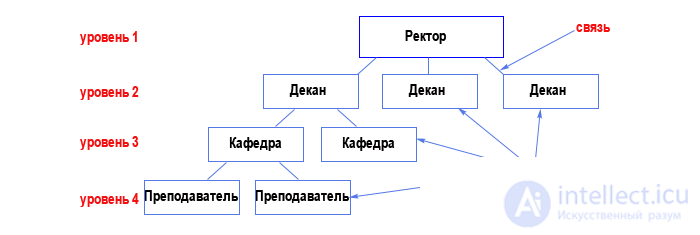Creating a database, we strive to organize information according to various criteria in order to then extract from it the data we need in any combination. This can be done only if the data is structured. Structuring is a set of conventions on how to present data. It is clear that information can be structured in different ways. Depending on the structure, hierarchical, network, relational, object-oriented and hybrid database models are distinguished. The most popular today is the relational structure, so the rest will be mentioned only in passing.
Hierarchical database structure
This is a tree view of information. Its peculiarity is that each node at a lower level has a connection with only one node at a higher level. Let's look, for example, at a fragment of the hierarchical structure of the database "Institute":

From the structure it is clear that several teachers can work in the same department. Such a connection is called
"one to many" (one department - many teachers). But if we try to add a group of students to this structure, we will need a
many-to-many relationship:

(one teacher can work with many groups, and one group can learn from many teachers), but there is no such connection in the hierarchical structure (since there can be a connection with only one node at a higher level). This is the main disadvantage of a similar database structure.
Network database structure
In essence, this is an extension of the hierarchical structure. All the same, but there is a
many-to-many relationship. The network structure of the database allows us to add groups to our example. The disadvantage of the network model is the complexity of developing serious applications.
Relational database structure
All data is presented in the form of simple tables, divided into rows and columns, at the intersection of which the data are located. We will talk about this in detail in the following lessons, but here we would like to note that this structure has become a real breakthrough in the development of databases.
Object Oriented and Hybrid Databases
In object-oriented databases, data is stored as objects, which is very convenient. But today such databases are still common, since inferior in performance relational.
Hybrid databases combine the capabilities of relational and object-oriented, so they are often called object-relational. An example of such a DBMS is Oracle, starting with the eighth version.
Undoubtedly, such databases will develop in the future, but for now the primacy remains with relational structures. Therefore, we will study them in the subsequent lessons.


Comments
To leave a comment
Databases, knowledge and data warehousing. Big data, DBMS and SQL and noSQL
Terms: Databases, knowledge and data warehousing. Big data, DBMS and SQL and noSQL